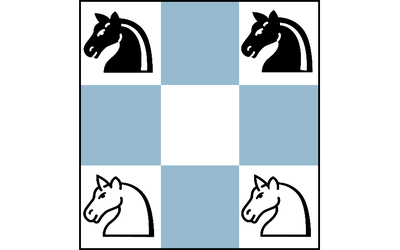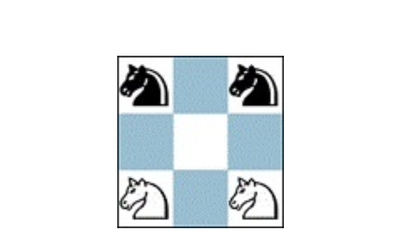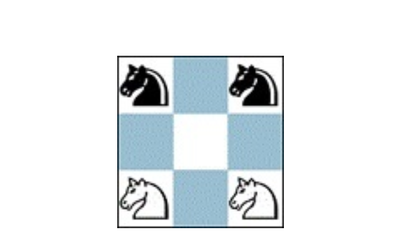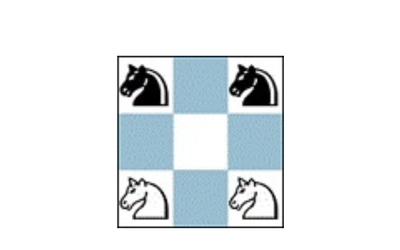
jomega
The unintended consequences of rule changes.
Capturing the intent of rule changes is not easy.For a definition of unintended consequences we can use this from Wikipedia:
"... recently, the law of unintended consequences has come to be used as an adage or idiomatic warning that an intervention in a complex system tends to create unanticipated and often undesirable outcomes."
It has happened many times in the history of chess, including modern times, that the complex system of the rules of chess have been intervened, and unanticipated, and often undesirable, outcomes occur.
Modern chess evolved from older forms of chess as people tried to codify the agreed on intent of the new rules. Compromises had to be made because people did not have the same intent initially. People differed on how pawn promotion should work, how castling was done, and how stalemate was to be handled - to name a few cases.
Let's consider some of the interventions with the rules and the outcomes.
The change to not capture the "King".
There undoubtedly was a time in a predecessor game to modern chess where the piece corresponding to the King was captured.
"It is a peculiarity of the game [Ed: an early version of a chess like game played in India] that the King is not obliged to move when attacked, and that the King is liable to capture precisely in the same way that every other piece is liable in the ordinary game." [AHC1913]
When the rule was changed to not allow the capture of the "King", a number of unintended consequences followed. The amount of words in the modern rules needed to handle the rule that you do not capture the King is amazing. Let's look at some of those.
Stalemate
What was now going to be the rule for when the opponent could not move at all, but his King was not in check? Today, this is called stalemate, and the game is a draw. However, that was not always the case.
"The rules regarding Stalemate have varied all through the history of the game, and this old Indian rule by which the victory is given to the player whose King is stale mated, illogical as it is, reappeared in England from 1600 to about 1800." [AHC1913, pg. 61]
Indeed, in [CME1750] we see on page xvi: [medial "S" replaced by "s"]:
"When the Adversary's King is so situated, that he cannot move without going into Check, and there is no other Piece to move ; that is called Stale-mat, and you lose the Game."
By you in "you lose the Game", is meant the opponent of the player who has no move except to move his King into check. Hence, if you stalemate your opponent, you lose! This was in 1750. By the time Steinitz wrote "The Modern Chess Instructor" in 1889, stalemate was a draw. [MCI1889]
The need to define "attack" and its variants.
Once the King could not be captured, it was necessary to define the concept of "attack". Of course that concept would also be needed to arrive at the modern rules for castling.
It had to be decided if absolutely pinned pieces still directly attack squares. I say directly attack because people generalize attack almost immediately after learning the rules of chess. A simple example of such a generalization is doubled Rooks, both of which are attacking some opponent's piece.
In modern chess, you cannot move your King (or capture with the King) on a square that is directly attacked by an opponent's man - even if that man is absolutely pinned to its own King. This includes squares the King moves over and onto while castling.
This is today explicitly stated in the rules. In FIDE rules, it is in rules 3.1.3 and 3.9.1. [FIDELOC2018]
"1.4 The objective of each player is to place the opponent's king 'under attack' in such a way that the opponent has no legal move.
1.4.1 The player who achieves this goal is said to have 'checkmated' the opponent's king and to have won the game. Leaving one's own king under attack, exposing one's own king to attack and also 'capturing' the opponent's king is not allowed."
Well, 'under attack' in 1.4 and 1.4.1 is not defined yet at that point. Also the concepts of "attack a piece" and "attack a square" have to be defined. From these come naturally the phrases "under attack", etc. in the above rules. The closest I see for the definitions are:
"3.1.2 A piece is said to attack an opponent's piece if the piece could make a capture on that square according to Articles 3.2 to 3.8.
3.1.3 A piece is considered to attack a square even if this piece is constrained from moving to that square because it would then leave or place the king of its own colour under attack.
...
3.9.1 The king is said to be 'in check' if it is attacked by one or more of the opponent's pieces, even if such pieces are constrained from moving to the square occupied by the king because they would then leave or place their own king in check.
3.9.2 No piece can be moved that will either expose the king of the same colour to check or leave that king in check."
I have read that some copies of the rules once said that one was in check when the King was under attack from one or two pieces. This caused a loophole in that you could move the King to be attacked by 3 or more pieces, and now, by definition, you were not in check!
In [CP1932, pg. 5] Staunton allows the definition of "check" to apply to more than a King! "Every Man attacks, checks, and guards the squares on which he could legally capture an adverse Man, from the position he occupies."
Castling rules.
Modern castling developed from an earlier rule known as the King's leap. The idea was to get the King to safety. What we would call castling took two moves; not necessarily consecutive. The Rook would move first and later the King would leap over the Rook.
In [CP1932] Staunton describes the various forms of castling adopted in different places at that time. One such rule was in used in Italy and Spain called Free Rochade, in which the King and Rook can be placed on any vacant square in the limits of, and including, their own two, provided they cross over each other.
The way Staunton describes the rule in this book it amounts to the same rule as the current modern rule. However, when FIDE first codified the castling rule in 1930, they did not specify that it had to occur on the player's first rank. The result was that the rules actually allowed castling with a promoted Rook! This became known as Pam Krabbe castling. Max Pam and Tim Krabbe both rediscovered this way of castling in 1972. This gap in the rules had earlier been discovered by Dane Conrad Staugaard. [PK].
So we see that the intervention of some sort of rule to get the King to safety had the undesirable outcomes of different ways of doing it, and the apparent difficult FIDE had in getting the final intended castling method codified.
The 3-position repetition rule, the 50-move limit draw rule, the dead position rule.
These can be looked at as attempts to get games to come to a timely conclusion.
John McCary has argued that the 3-position repetition evolved from rules made for the London 1883 Tournament. That rule said
"... if a series of moves be repeated three times the opponent can claim a draw."
Note that this says "moves" not "positions". Even so, the rule is ambiguous, as McCary points out. See [EWCN3461]. There we see:
"That rule was too vague, a sub-committee of the tournament defined the idea more precisely as part of a proposed new code, published with the tournament book for use in future international events. And that became the basis of our modern rule."
But why was the rule created? McCary says...
"It may have to do with chess clocks and time limits. That same London 1883 tournament pioneered a new type of chess clock with two clocks joined together in a single apparatus, as they are today. London 1883 also provided that the player exceeding his time limit forfeited the game. That rule was a relative novelty, as previously players were often only fined, not forfeited. In fact, time limits did not exist before the 1860s, and sandglasses were first used for timing the games before clocks were adapted for that purpose.
So the triple-occurrence draw rule may have been created partly because of concerns that a player might repeat moves to avoid time forfeits ..."
So the intervention of chess clocks, which I'll discuss below, had the unintended consequence of people trying to avoid overstepping the time control, and hence repeating moves/positions, and that led to the 3-position repetition rule. Later the 3-position repetition rule had to be modified to answer various questions on intent - such as, say, whether a position was the same if the King Rook and Queen Rook were swapped.
See [HCT1895, pg. 118 footnote 8]. Thus, in the current FIDE rules [FIDELOC2018]:
"9.2.2 Positions are considered the same if and only if the same player has the move, pieces of the same kind and colour occupy the same squares and the possible moves of all the pieces of both players are
the same. Thus positions are not the same if:
9.2.2.1 at the start of the sequence a pawn could have been captured en passant
9.2.2.2 a king had castling rights with a rook that has not been moved, but forfeited these after moving. The castling rights are lost only after the king or rook is moved."
You can imagine how long it took to get this wording to match what had become the intent.
The 50-move limit rule was also fraught with difficulties. Per [EWCN8509], here is an early version:
"The rule in effect was that of the Chess Association of the United States of America, published on pages 167-168 of the Book of the Fifth American Chess Congress:
'Counting 50 moves. If, at any period during a game, either player persist in repeating a particular check, or series of checks, or persist in repeating any particular line of play which does not advance the game; or if 'a game-ending' be of doubtful character as to its being a win or a draw, or if a win be possible, but the skill to force the game questionable, then either player may demand judgment of the Umpire as to its being a proper game to be determined as drawn at the end of 50 additional moves, on each side ...'"
For more instances in history of the 50-move limit rule controversies, see [EWCfifty]. For more on the history of this rule, and FIDEs various attempts to codify this, see [WIKI50HISTORY]. The current FIDE rule for the 50-move limit is in rules 9.3, 9.3.1 and 9.3.2. [FIDELOC2018].
Another rule to get games to come to a timely conclusion is the FIDE rules on 'dead positions'. A dead position is "Where neither player can mate the opponent's king with any series of legal moves." [FIDELOC2018] The game ends immediately per rule 5.2.2. This rule causes issues for online chess because no chess software has ever been written than can correctly identify all dead positions!
The phrase 'mate the opponent's king with any series of legal moves' appears in a number of FIDE rules. The intent of the rules is that you cannot lose a game if your opponent cannot mate you with any series of legal moves; that is no matter how badly you play, you simply cannot be mated. This intent is the reason for the drawn games by rules 5.2.2 (neither player can mate with any series of legal moves), 6.9 and A.4.3 (exceptions to losing on overstepping the time limit), and 7.5.5 (exception to losing on making several illegal moves).
The FIDE rule 5.2.2 covers what most people think of as rules about "insufficient material for mate". However, FIDE rules never talk about such a concept as "insufficient material for mate".
"5.2.2 The game is drawn when a position has arisen in which neither player can checkmate the opponent's king with any series of legal moves. The game is said to end in a 'dead position'. This immediately ends the game, provided that the move producing the position was in accordance with Article 3 and Articles 4.2 - 4.7." [FIDELOC2018]
This covers the positions Kk, KBk, KNk, and many others. However, note that it does not say that KNNk or KBkp is a draw. Suppose that Black oversteps the time limit in a KBkp endgame, but claims he should at least get a draw because "White cannot possibly mate because he has insufficient winning material." However, the FIDE rule does not talk about such a thing, and the claim is incorrect because it might be possible for either player to mate. Here is an example:
Now Black in the case above changes his argument and says, "Black has insufficient losing chances in this position, and hence should get a draw." However, there is no such rule as this in the FIDE rules. There is such a rule in special circumstances in the USCF rules! An entire blog would be needed to describe the differences between FIDE and USCF rules!
The clock.
The most impactful rule changes to chess since the changes to the modern moves of the pieces has to be due to the introduction of the clock in chess.
Like the 3-position repetition rule, the 50-move limit draw rule, and the dead position rule, the clock was also an attempt to get games to come to a timely conclusion. Indeed, it is clear that this was the intent, and that clock rules were not intended to change what was actually happening on the board. This can be seen by today's FIDE rules - for example the dead position rule declares such a game a draw, and the game ends immediately. Also consider rule 6.9 of the FIDE rules:
"6.9 Except where one of Articles 5.1.1, 5.1.2, 5.2.1, 5.2.2, 5.2.3 applies, if a player does not complete the prescribed number of moves in the allotted time, the game is lost by that player. However, the game is drawn if the position is such that the opponent cannot checkmate the player’s king by any possible series of legal moves."
Before the introduction of the clock, spectators, players, and tournament directors complained about "endurance matches" - such as a single game lasting more than 9 hours.
For a while, overstepping the time limit would only result in a fine. An example of this was the rule in the Paris International Tournament of 1867, where sandglasses were used. [BWCLOCK] However, at the the Hastings Chess Tournament, 1895, exceeding the time limit meant that you forfeited the game. [HCT1895, pg. 7]
I also note here that I see nothing in that 1895 tournament's rules that say you get a draw after exceeding the time limit if your opponent cannot mate you by any series of legal moves! My guess is that people would appeal to the tournament's rules committee in such cases, and they'd get the draw, and it would have been cases such as this that eventually lead to the rule 6.9 in FIDE rules.
Losing the game on exceeding the time limit became the norm - with the above caveat.
Here are some sample time controls through history after the intervention of the chess clock.
I'm using the PGN format from the TimeControl tag.
n/m: n moves in the period, m seconds for the period etc.
1870 Baden-Baden, 20/3600 [BWCLOCK]
1883 London Tournament, 15/7200 [BWCLOCK]
1895 Hastings Chess Tournament, 30/7200:15/3600 [HCT1895]
1908 Lasker vs Tarrasch, World Chess Match, 15/3600 [LT1908]
1909 International Chess Congress St. Petersburg, 37/9000:23/5400:50/3600 [ICCSP1909]
1927 Capablanca vs Alekhine, World Chess Match, 40/9000
2021 WCC 40/7200:20/3600:900+30
Promotion to an opponent's piece!
Pawn promotion had many different variants in history, but by about the 1700s, the rule's intent would be as the intent today. Hence, we have the following...
"When a Pawn gets to the opposite Side of the Board, it becomes a Queen or other Piece that is wanting." [CME1750, pg. 3]
"Every Pawn which has reached the eighth or last square of the chess-board, is entitled to make a Queen, or any other Piece that shall be thought proper; and this, even when all the Pieces remain on the chess-board." [AHC1913, pg. 835 referring to Philidor's "Analysis" of 1790]
"A Pawn reaching the eighth square must be named as a Queen or Piece, at the option of player, independent of the number of Pieces on the board. The created Queen or Piece acts immediately in its new capacity. Until the Pawn has been so named the move is incomplete." [HCT1895, pg. 9]
However, each of these fails to say that the color of the promoted piece has to match the color of the pawn! I don't know when this was fixed in the rules, but current FIDE rules have it as intended.
Conclusion
These examples show that the law of unintended consequences has plagued chess rule writers since the inception of the modern game. FIDE continues to modify their rule handbook so as to clarify intent, and to plug loopholes. It is a slow process. Currently, any modifications only occur on a 4 year cycle. You can find out more about the FIDE Rules Commission here [FIDERULESCOM].
References
[AHC1913] "A History of Chess" by H. J. R. Murray, 1913
[BWCLOCK] Chess clocks, http://billwall.phpwebhosting.com/articles/Chess%20clocks2.htm
[CA1927] Capablanca vs Alekhine 1927, https://www.chessgames.com/perl/chess.pl?tid=54140
[CME1750] "Chess Made Easy or, the Games of Gioachino Greco", by anon, 1750
[CP1932] "Chess praxis" by Howard Staunton, 1932
[EWCN3461] Repetition, https://www.chesshistory.com/winter/winter02.html#CN_3461
[EWCN8509] Fifty-move limit, https://www.chesshistory.com/winter/winter114.html#CN_8509
[EWCfifty] Chess: the 50-move Rule, https://www.chesshistory.com/winter/extra/fifty.html
[FIDELOC2018] FIDE Laws of Chess, 1 January 2018
[FIDERULESCOM] FIDE Rules Commission, https://rcc.fide.com/
[HCT1895] "The Hastings Chess Tournament", 1895
pg. 7 says 30/2hrs 15/1 hr, and exceed time forfeits the game.
pg. 118 footnote 8 mentions that the rule of 3-position repetition required
the position to be the same but was unclear on whether swapping the
King and Queen Rooks would constitute a different position. The editors
overruled that interpretation. As it is today, that would be the same position.
[ICCSP1909] "International Chess Congress St. Petersburg 1909
Rule 9 pg. VIII specifies that overstepping the time limit foreits the game.
[PGNSTANDARD] 9.6 Time Control, http://www.saremba.de/chessgml/standards/pgn/pgn-complete.htm#c9.6
[LT1908] Lasker vs Tarrasch 1908, https://www.chessgames.com/perl/chess.pl?tid=54099
[MCI1889] "The Modern Chess Instructor", by W. Steinitz
[PK] https://de-m-wikipedia-org.translate.goog/wiki/Pam-Krabb%C3%A9-Rochade?_x_tr_sl=auto&_x_tr_tl=en&_x_tr_hl=en&_x_tr_pto=nui
[WIKI50HISTORY] Fifty-move_rule History, https://en.wikipedia.org/wiki/Fifty-move_rule#History



